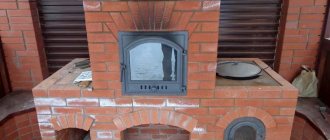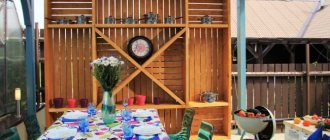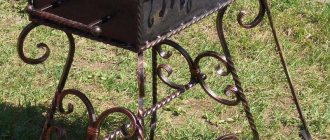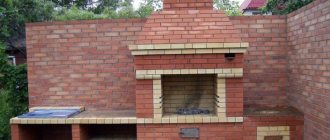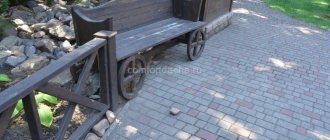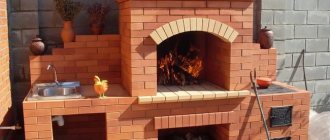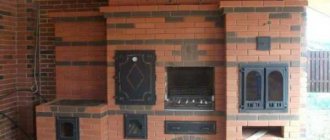A brick barbecue on the site of a private house or cottage is the central element of a recreation area. The stove can be placed in a gazebo or on the street, as an independent structure or as part of an entire complex - there are a lot of placement options and combinations of different functions.
Peculiarities
A brick barbecue is a stationary outdoor fireplace. And when designing, it is necessary to take into account the features of its installation and placement.
Types of barbecue and placement features
There are two types of outdoor brick barbecues: a single oven and a complex of oven devices.
In the first case, it can be a closed or open hearth with provisions for installing a spit, skewers or grate over smoldering coals.
If it is an open hearth, without a domed vault and a chimney, then it can only be located in the open air, subject to appropriate fire safety measures.
But if you take a strict approach, it is not easy to comply with these measures in the limited space of the local area.
A closed stove with a chimney can be placed either outdoors or in a gazebo (or under a canopy).
And quite often, owners are not content with just one barbecue function - baking food in the heat of burnt wood or charcoal. Here, nearby, they can put a stove with a hob, a tandoor, sections for storing firewood, a work table for cutting meat and preparing food. And this is a whole complex for cooking on the street.
But in any case, when choosing a location, they are guided by the standards for the placement of auxiliary (service) structures on the site - minimum distances from the house, the border with the neighboring site, and separate trees.
When a barbecue area is equipped with all the “conveniences” (water, drainage, electricity), then the proximity of utility networks and the possibility of connecting to them must be taken into account. If the connection to the water supply is not provided for according to the plan, then the stove should be located closer to the summer kitchen or not far from the house from the side of the regular kitchen.
Installation Features
Any brick structure, regardless of its size, requires a good foundation. And a stove is best suited for these purposes.
Moreover, when arranging a shallow strip foundation, it is necessary to take into account the characteristics of the soil. And they are such that the tape may not withstand the forces of frost heaving, and cracks will appear in the brickwork. The slab is a universal type of base, and it works well even on weak and floodable soils.
Usually the main counterargument against a slab is the high consumption of concrete. But for such a relatively small structure as a barbecue oven, not so much of it will be needed.
Varieties by location
Installation is permissible both indoors and outdoors. Taking this factor into account, barbecues come in two types.
Street (garden)
It is mounted under a small canopy so that precipitation and moisture do not get inside the chimney, and you can cook in any weather.
Another option is to do it outdoors, in the garden, near a gazebo, near the house. In any case, a reliable foundation is poured under the structure. A monolithic slab is considered optimal.
The masonry of the barbecue is made of fire-resistant bricks, the cladding is made of moisture-resistant materials.
It is important to choose the right location for the garden structure, taking into account the direction of the wind, so that there are no dry trees or wooden buildings nearby. To avoid conflicts with neighbors, it is better to first familiarize yourself with the SNiP standards.
To the gazebo (veranda or terrace)
Installed in open and closed buildings. At the project development stage, fire safety requirements are taken into account, and the location for the chimney outlet is carefully considered. Requires pouring a separate foundation.
It is recommended to lay out the floor covering near the stove from non-flammable materials:
- paving, ceramic tiles;
- clinker bricks;
- artificial, natural stone.
An alternative is to place a sheet of iron or steel on the floor at a distance of 1.5 m from the stove.
Visually, the room is divided into zones: kitchen and dining.
Laying the foundation
You can lay a finished road slab as a base, but this option has more disadvantages than advantages. And usually the foundation is poured with your own hands. The area of the slab is made according to the size of the furnace, with small tolerances around the perimeter. And the area in front of the barbecue is then laid out with the same tiles as the paths on the site.
Even at the design stage, the excavation depth and the thickness of the slab are calculated so that the surface of the slab rises 50-60 mm above the ground.
If the barbecue oven is relatively small, then it is enough if the thickness of the slab is within 10 cm. For a large oven complex, it is better to calculate the parameters of the slab based on the properties of the soil and the total load on the base. In this case, it may be necessary to fill a slab with a thickness of 12-15 cm.
Preparation
A step-by-step algorithm for preparing a site for concreting looks like this:
- Mark the place with pegs and string.
- Remove the top layer of soil to a depth of about 30 cm.
- Level and compact the bottom.
- Install formwork from edged boards or OSB strips. For reliability, tie the corners with “kerchiefs” made from scraps of material.
- Fill with crushed stone and sand in a total layer about 15-20 cm thick. Level, water and compact with a tamper.
- Cover the separating layer with rolled waterproofing. It will protect the foundation from getting wet by groundwater, and will not allow moisture to escape into the sand from the concrete during its maturation. The strips are laid overlapping by 15-20 cm, with access to the end of the future slab.
- A mesh of reinforcement is placed on the supports. You can link it yourself, but it’s easier to use a road grid map with parameters 100x100x6.0 mm or 150x150x8.0 mm. The reinforcement should lie approximately in the middle of the slab at a distance of at least 30 mm from the bottom and top surfaces. Along the perimeter, the mesh should not reach the boundaries of the formwork by 30-50 mm.
Furnace finishing
The Stonehenge stove does not require special finishing, since the bricks were carefully prepared during laying. All you need is to join the wide seams, which is ideally done during the laying process, but it can be done later. The jointing is done with a special tool. Its purpose is to give the building an aesthetic appearance.
Joining the seams allows you to give the stove an aesthetic appearance
It is better to prime all metal parts and paint them with stove varnish or any heat-resistant paint.
The door of the cauldron compartment must be coated with heat-resistant paint
Orders
A barbecue oven, especially an oven complex, requires proper ordering. The “fault” is the presence of a chimney and the need to adjust the draft. In this design, it is practically no different from a fireplace or a Russian stove, and calculating the order from scratch is not so easy. But you don’t have to do this yourself - there are quite a lot of designs for stoves of any size and functionality on the Internet:
- Small oven:
- Barbecue with woodpiles:
- BBQ oven with cauldron:
Video description
Layer-by-layer construction of a barbecue oven:
Metal parts can be made to order. But it’s easier to buy them ready-made, since they are produced in standard sizes. Everything must be secured and installed in accordance with the technology and design.
At the last stage, the fireplace is lined. You can leave it just brick, but to give it a more aesthetic appearance, some kind of fire-resistant facing material is used. The most commonly used are natural stone and ceramic tiles.
Brick, masonry mortar, other materials
When building a barbecue, you will need two types of bricks: fireclay and regular. Fireclay is needed for laying the firebox and chimney.
Firebox made of fireclay bricks
The furnace body is made of ordinary brick. And this circumstance must be taken into account when calculating the amount of brick.
Ordinary ceramic bricks come in only one size - 250x120x65 mm (not counting one-and-a-half or double formats). And fireclay (or stove) bricks can be of different sizes.
The brand of fireclay brick ShB-8 (250x124x65 mm) is closest to a regular ceramic block, and this “extra” 4 mm of bed width is compensated for by the different thickness of the masonry joint. In other cases, the sizes differ quite significantly.
Video description
Option for facing an outdoor fireplace:
An outdoor fireplace can be built not only from brick, but also from wild stone or concrete. Stone structures are very efficient and economical. However, when constructing them, the stove maker must demonstrate the highest level of skill, since it is quite difficult to lay out a correct and aesthetic stove structure from a material that is not ideal in shape.
Outdoor stone fireplace Source a-bicycleshop.com
Concrete stoves come in a variety of shapes. This plastic material allows you to create unusual stove structures. But using concrete to build fireplaces requires serious qualifications. Concrete structures are built using the formwork principle, using concrete slabs or using concrete rings. In any case, the structure turns out to be quite heavy, and under it, like under a brick fireplace, there must be a strong foundation.
Concrete slab oven Source otto.nl
Masonry
The brick oven is laid using a standard set of masonry tools, which includes:
- level, plumb line, square;
- cords;
- templates for masonry joints of different thicknesses (for the firebox and chimney - 3 mm, for other parts of the stove body - 5-8 mm);
- trowels;
- mallet;
- pickaxe, grinder with a disk for adjusting the dimensions of bricks and steel angles;
- jointing
The first rows are laid out dry first. They check the proportionality of fireclay and ordinary bricks, determine the size of the trim where it is necessary.
Then the laying begins. An ordinary brick is moistened by dipping it in a bucket of water for a couple of minutes. Fireclay bricks are only rinsed. After adjustment, the fireclay brick must be laid so that the side pounded with a mallet or cut with a disk faces outward, and not into the firebox or chimney. The masonry process itself involves bandaging the seams, with periodic monitoring of the vertical walls and horizontal seams.
After finishing the masonry, the stove is dried under natural conditions for 5-7 days. And then they are heated for one to two weeks (depending on the size and weight of the structure).
Small brick barbecue project for beginners:
Operating rules
The stove will last a long time if you care for it properly. Clean the grates of dirt after each frying, and the chimney at least once every six months.
It is important to follow fire safety precautions:
- control the intensity of the fire;
- do not allow flammable objects near the heat;
- Do not use gasoline or kerosene for ignition.
To avoid gradual destruction of the structure due to sudden temperature fluctuations, before using in cold weather, the device must be dried over low heat for 15 minutes.
Assembling a barbecue with your own hands according to drawings and photos will not require much effort if you follow the step-by-step instructions.
The store, of course, sells outdoor ovens, but dishes prepared on a personally built structure will seem even tastier, and your heart will be filled with joy for such independent work.
Temporary barbecue of their bricks
You can make a temporary barbecue oven out of brick - without using mortar. For these purposes, you can use ordinary brick - an open hearth (without a chimney) and small gaps in the masonry will ensure a thermal regime acceptable for ceramics.
A step-by-step algorithm for constructing a temporary barbecue looks like this:
- Prepare a flat and firm area on the ground. You don’t even have to remove the humus layer - just cut off the vegetation, level and compact the surface.
- Cover with a couple of layers of roofing material.
- Lay out the first tier of bricks with small gaps between the prongs and tongues of adjacent elements.
- The second tier is placed in a dressing with the first, maintaining approximately the same size gaps.
- The next rows are laid out in the same way. The masonry is laid to a height convenient for using a barbecue. You need 10-11 such rows. At this height, a steel sheet is placed on the bricks, which will serve as a tray for coals.
- Lay it dry on the sides and back of the wall, two bricks high. Lay and secure the grate.
- The walls are increased in height by another two or three bricks.
Such a stove can be laid out in a couple of hours. And take it apart in the same amount of time. A good option for a summer house or a small local area.
Operating principle and advantages
The word barbecue (from the French, abbreviated BBQ) means roasting meat over a “live” fire or coals. This is also the name of a device that works using this method and combines all the advantages of a barbecue, smokehouse and grill.
In addition to steak, you can use it to fry wings, sausages, smoke seafood, bake fish or vegetables. The stove can handle drying berries and mushrooms. You can cook pilaf and even soup on it.
All these numerous cooking methods are possible due to the design features, consisting of the following parts:
- Box with back wall. Thanks to the high sides, heat is not blown out and the required temperature is maintained inside the container. Therefore, frying is carried out without the risk of drying out and burning the food.
- A tray for coals, which is located in a special safe firebox.
- Grids for products.
Many products have a chimney to make it comfortable to cook or have a picnic nearby. If you install such a fireplace in semi-closed gazebos or terraces, it will heat the room.
Photos of brick barbecue projects
dizlandshafta
How to make a round grill in the ground with your own hands
Often, summer residents do not want to bother with complex drawings when building a barbecue. You can do it simply and make it right in the ground.
The simplicity of the device and unpretentious design will not spoil the appearance of the site
The whole family can gather around such a fireplace on summer evenings. An additional plus: the roaster is multifunctional, suitable for preparing kebabs and grilled foods. It is easy to build a round brick or stone structure within a few hours.
To make a round brick grill in the ground with your own hands, you need to follow simple instructions:
- Clear the area of debris and remove vegetation.
- Draw an even circle on the ground using a barrel or large lid.
- Dig a hole with a depth corresponding to the length of the brick. It is important not to protrude beyond the edges of the circle.
- Line the inner walls of the recess with bricks, placing them vertically.
- Place a layer of sand at the bottom of the hole. This will limit the access of moisture from the soil.
- Around the pit, make an embankment of crushed stone, rubble, or lay out a decorative edging of flat stone. This will prevent the fire from spreading and burning the grass around the fire pit.
The round brick grill in the ground is ready.
Smooth brickwork in the shape of sun rays looks beautiful
Creating the base part
During the construction of a brick plinth, a masonry mortar of cement and sand is used:
- When creating a solution, one volume part of cement and four volume parts of sand are mixed. After this, water is added and the mixture is stirred until it reaches a uniform consistency.
- To prevent moisture from entering, waterproofing is made of several layers of roofing felt.
- The bottom row of the base part is laid continuously.
- During installation, you need to take into account the length of the grill. If it is less than one meter, then the thickness of the masonry can be half a brick.
- Large barbecues should have a masonry thickness of one brick or more. In this case, it is necessary to stiffen the tabletop. This can be done using a vertical transverse partition, laid out in half a brick.
